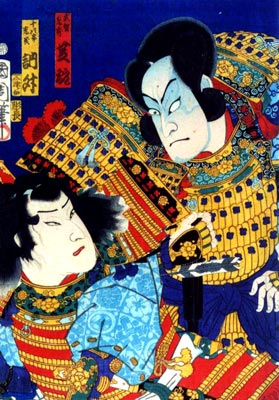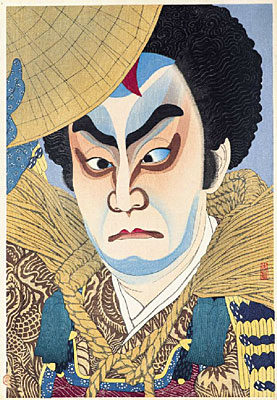| AMAGASAKI KANKYO |
| Play titles | Ehon Taikôki Ehô Taikôki |
||||||||||
| Common titles | Amagasaki Kankyo Taijû |
||||||||||
| Authors | Chikamatsu Yanagi, Chikamatsu Kosuiken, Chikamatsu Sen'yôken (1799 puppets version) Nagawa Tokusuke I (1800 Kabuki version) |
||||||||||
| History |
The play "Ehon Taikôki" was originally written for the puppet theater (Bunraku) and staged for the first time in the 7th lunar month of 1799 in Ôsaka at the Toyotakeza. It was adapted for Kabuki the next year by Nagawa Tokusuke I, entitled "Ehô Taikôki" and staged for the first time in the 11th lunar month of 1800 in Ôsaka at the Kado no Shibai [casting]. It was staged with the original title for the first time in the 7th lunar month of 1802 in Kyôto at the Kitagawa no Shibai. The title "Ehô Taikôki" was still used in Ôsaka up to the beginning of the 1820s. Because of strict censorship, the authors had to change the names of the characters:
"The play consisted originally of thirteen acts, one act for each day that passed between Akechi Mitsuhide's murder of Oda Nobunaga and his death at the hand of Toyotomi Hideyoshi. The tenth act is the only one which has survived. This act tells of an incident during the battle in which Mitsuhide was finally defeated. When Akechi Mitsuhide determined to murder Oda Nobunaga, he laid his plans carefully. He chose a time when Nobunaga was in Kyôto with a bodyguard of not more than two hundred men, while his other forces were dispersed far from the capital. In particular, the two men Mitsuhide knew to be most likely to thwart his plans were, he trusted, in no position to resist him. Toyotomi Hideyoshi was away, laying siege to the castle of Takamatsu in Bicchû, the last stronghold of Nobunaga's enemy Mori Motonari. Ieyasu was awaiting Nobunaga at Sakai with a small contingent. Mitsuhide arranged for Sakai to be surrounded at the same time as he made his own coup. Ieyasu escaped capture through the friendly warning of a local tea-grower. Mitsuhide had, however, underestimated Toyotomi Hideyoshi. Having brought Takamatsu Castle to its last gasp, Toyotomi Hideyoshi was able to conclude a speedy truce with Mori. He hurried back to Kyôto by forced marches, surprised Mitsuhide at Yamazaki, and defeated him. Legend has it that Toyotomi Hideyoshi killed Mitsuhide with his own hand, but, in fact, he was cut down by a peasant as he fled from the field." (Aubrey and Giovanna Halford in "The Kabuki Handbook") Only the tenth act became a classic of the Kabuki reportoire. The National Theatre had the good idea to produce a tôshi kyôgen revival of "Ehon Taikôki", staging acts 1, 2, 6, 9 and 10 in November 2005 [casting]. |
||||||||||
| Structure |
This play is made up of 13 acts. The 10th act, the "Amagasaki Kankyo" act, is still part of the Kabuki repertoire and is staged quite often. |
||||||||||
| Key words |
Gidayû Kyôgen Jidaimono Mashiba Hisayoshi Oda Harunaga Ôtoshi Satô Masakiyo Sengoku Jidai Takechi Mitsuhide Taikôki Yamazaki no Tatakai |
||||||||||
| Summary |
When Takechi Mitsuhide has rebelled against Oda Harunaga, Mitsuhide's mother Satsuki didn't forgive him. She left from Mitsuhide's mansion to a cottage in Amagasaki. Mitsuhide's wife Misao and his son Jûjirô's fiancee Hatsugiku went there to visit her. A mendicant monk arrives at the cottage and asks Satsuki to be allowed to stay here tonight.
Satsuki recognizes him as Mashiba Hisayoshi but do not let him understand that she has penetrated his disguise.
She offers him to take a bath first. The monk brings news, which are bad for Mitsuhide's side,
who has been cornered by an avenging army led by Mashiba Hisayoshi. Mitsuhide suddenly appears on stage and steals up to the cottage.
He also has recognized his sworn enemy and decides to retire into the bamboo thicket,
biding his time to strike Hisayoshi. Jûjirô visits the cottage in order to get the permission to join his father's army. It is his first battle and he knows that he must die on the battlefield. Although Jûjirô decided to throw away even his life, he is worry about his fiancee Hatsugiku. He thinks that she had better forget him soon, and he hopes that she would happily marry with another man. Hatsugiku, who was in the next room, has been listening to his monologue. She stumbles into the room, weeping and saying that she doesn't intend to marry anyone except Jûjirô. The young warrior makes her help him wearing his armor suit, and she is feeling deeply sad. Once Jûjirô is in full armor, his mother and grandmother brings the ceremonial cups and sake in order to make him do the ceremony of exchanging a marriage sake cup with Hatsugiku. Jûjirô is confused of it, because he knows that he must die. His mother Misao and his grandmother Satsuki have decided to organize this wedding as a farewell ceremony for Jûjirô, because they also have understood that Jûjirô will soon meet his fate. After the ceremony, Jûjirô goes heading to the battlefield. The three women are left crying unhappily. Mitsuhide comes creeping into the garden. He is disguised as a farmer with a straw cloak and hat. He knows that Mashiba Hisayoshi went into the bathroom. He cuts a bamboo to make a spear and goes into the room silently. Then, he violently stabs the paper door with his long bamboo spear, because he thinks that Hisayoshi is there. A cry is heard and he withdraws the spear, which is cut in half. In fact, Mitsuhide accidentally stabbed his own mother Satsuki instead of his sworn enemy. Misao and Hatsugiku come back into the main room being surprised. Misao finds that the murderer is her husband. Meanwhile all of them can say nothing. Satsuki regrets that if Mitsuhide didn't rebel against his lord Harunaga, he wouldn't have done such a tragedy, becoming a mother killer. Mitsuhide answers that the revolt wasn't wrong and he refuses to listen to her mother. She asks Misao to plead her cause to her husband and he turns a deaf ear to her as well. Jûjirô comes back. Misao and Hatsugiku run to Jûjirô, and they find that he got wounded seriously. Jûjirô reports about the battle to his father Mitsuhide. He advises Mitsuhide to get back to his domain, because his army has continued a hard fight. He finally dies in the arms of his wife. Satsuki dies shortly afterwards. Mitsuhide lost both his mother and son at the same time. He sheds tears at last (ôtoshi). A battle drum sounds. The stage revolves and Mitsuhide climbs on the top of an eminence to look around the surrounding countryside. He finds the army of Hisayoshi and witnesses the frantic retreat of the remains of his own troupe. The stage revolves back to the cottage and Hisayoshi enters to the main room. He is no more a monk but a glorious warlord with his military escort. His faithful warrior Satô Masakiyo rushed to the cottage on the hanamichi. Mitsuhide is completely surrounded. However Hisayoshi gives Mitsuhide the opportunity to escape. They promise to meet again later on the battlefield. This summary has been written by Sekidobashi Sakura (October 2001) and edited by Shôriya Aragorô |
||||||||||
| Comments |
"Act X, commonly called "The Amagasaki Scene", retains to a considerable degree the atmosphere of the puppet theatre. The jôjûri singers are more than mere narrators and in places perform the whole dialogue while the actors mime. The acting is modeled closely on that of the dolls." (Aubrey and Giovanna Halford in "The Kabuki Handbook") |
 |
 |
|
Sawamura Tosshô II and Nakamura Shikan IV playing the roles of Jûjirô and Takechi Mitsuhide in a print made by Toyohara Kunichika in the 8th lunar month of 1868 |
Ichikawa Chûsha VII playing the role of Takechi Mitsuhide in the drama "Ehon Taikôki" (print made by Natori Shunsen in 1926) |
|
|
| Contact | Main | Top | Updates | Actors | Plays | Playwrights | Programs | Links | FAQ | Glossary | Chronology | Illustrations | Prints | Characters | Derivatives | Theaters | Coming soon | News |